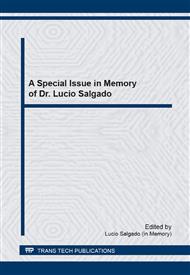p.311
p.319
p.325
p.331
p.337
p.343
p.350
p.356
p.362
Use of the Processed Waste from Kaolin and Granite Sawing in the Manufacture of Tubular Ceramic Membranes
Abstract:
The incorporation of waste from various industrial activities in ceramic products comes as a technological alternative to reduce the environmental impacts caused by the indiscriminate disposal of wastes in the environment. The kaolin and granite processing industries have been mentioned as sources of contamination and pollution, due to the enormous amounts of wastes they produce. The use of these wastes as raw material and its transformation into products that can be commercialized and/or show economic viability, presents as an alternative to the industries. The aim of this work was to use ceramic masses incorporated with kaolin waste (35%), granite (35%) and bentonite (30%) for the confection of tubular ceramic membranes using extrusion as production process. The ceramic mass was characterized through analysis techniques of thermogravimetric, chemical, particle size and X-ray. The membranes produced, after sintering in temperatures of 850, 900, 950 and 1000 oC, were submitted to characterizations of scanning electron microscopy, mercury porosimetry and permeability test by tangential flow. The preliminary result of the particle size analyses identified that the ceramic mass presents an average particle diameter of 37.00μm. The membranes presented porosity of approximately 32%, and average pore diameter within the ultrafiltration range.
Info:
Periodical:
Pages:
337-342
Citation:
Online since:
September 2014
Price:
Сopyright:
© 2015 Trans Tech Publications Ltd. All Rights Reserved
Share:
Citation:



